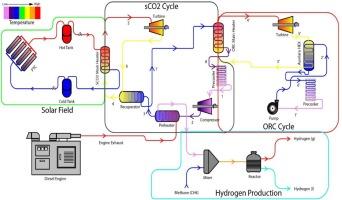多发电系统混合太阳能驱动超临界CO2循环的热经济评价
IF 7.6
Q1 ENERGY & FUELS
引用次数: 0
摘要
聚光太阳能(CSP)与热力学动力循环相连接,用于将太阳能转化为电能。本研究研究了两个发电循环的组合,其中顶部循环利用超临界二氧化碳(sCO2),有机朗肯循环(ORC)作为底部循环。在没有太阳能的情况下,柴油发动机的废气被用作备用能源。一个额外的制氢装置连接到系统上,通过蒸汽甲烷重整(SMR)方法过程制氢,并在从混合系统获得可用热量时运行。这个实验是在孟加拉国的Rangpur进行的。由于性能系数较高,分别选择Therminol VP-1、CO2和R245fa作为抛物槽集热器(PTC)、sCO2和ORC的工质。对单独使用sCO2与sCO2- orc组合使用的效率进行了比较。在250 bar压力下,混合动力模型的最佳结果为质量流量为82 kg/s,净功率输出为6062 kW,比投资成本(SIC)为5237美元/kW。结果还表明,所开发的混合模型比单独的sCO2效率提高了68.5%。另一方面,通过SMR方法,发现288 kg/h是甲烷的理想质量流量,相应的成本为100.8美元/h,有效产氢速率为62.87 kg/h。混合模型的输出显示了多种结果,如电力和氢气,使该系统成为一个多代系统。本文章由计算机程序翻译,如有差异,请以英文原文为准。

Thermo-economic assessment of hybrid solar-driven supercritical CO2 cycle for multi-generation system
Concentrated solar power (CSP) connected to a thermodynamic power cycle is used to convert solar energy into electricity. This study investigates a combination of two power generation cycles, where the topping cycle utilizes supercritical carbon dioxide (sCO2), and the organic Rankine cycle (ORC) serves as the bottoming cycle. The diesel engine exhaust is utilized as a backup source when solar energy is not available. An additional hydrogen production unit is connected to the system for producing hydrogen through the steam methane reforming (SMR) method process and operated when available heat is obtained from the hybrid system. This experiment was carried out in Rangpur, Bangladesh. Due to a higher coefficient of performance, Therminol VP-1, CO2, and R245fa were selected as working fluids in parabolic trough collectors (PTC), sCO2, and ORC, respectively. The comparison of standalone sCO2 with the combination of sCO2-ORC has been conducted in terms of efficiency. The optimal results for the hybrid model have been found as a mass flow rate of 82 kg/s, net power output of 6062 kW, and specific investment cost (SIC) of 5237 $/kW at the pressure of 250 bar. The results also showed that the developed hybrid model achieved 68.5 % higher efficiency than standalone sCO2. On the other hand, through the SMR method, 288 kg/h is found to be the ideal mass flow rate of methane, with a corresponding cost of $ 100.8/h, which produces hydrogen efficiently at a rate of 62.87 kg/h. The output of the hybrid model shows multiple outcomes, such as electricity and hydrogen, making this system a multi-generation system.
求助全文
通过发布文献求助,成功后即可免费获取论文全文。
去求助
来源期刊

Energy Conversion and Management-X
Multiple-
CiteScore
8.80
自引率
3.20%
发文量
180
审稿时长
58 days
期刊介绍:
Energy Conversion and Management: X is the open access extension of the reputable journal Energy Conversion and Management, serving as a platform for interdisciplinary research on a wide array of critical energy subjects. The journal is dedicated to publishing original contributions and in-depth technical review articles that present groundbreaking research on topics spanning energy generation, utilization, conversion, storage, transmission, conservation, management, and sustainability.
The scope of Energy Conversion and Management: X encompasses various forms of energy, including mechanical, thermal, nuclear, chemical, electromagnetic, magnetic, and electric energy. It addresses all known energy resources, highlighting both conventional sources like fossil fuels and nuclear power, as well as renewable resources such as solar, biomass, hydro, wind, geothermal, and ocean energy.
 求助内容:
求助内容: 应助结果提醒方式:
应助结果提醒方式:


